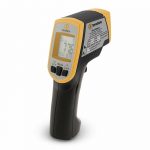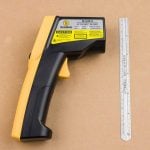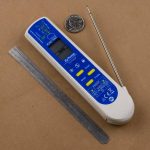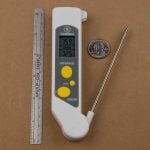How to Buy the Best Infrared Thermometer

An infrared thermometer is a handy device to have, but it isn’t really essential in the kitchen. Nevertheless, they have their advantages when it’s important to know the temperature of your cooking surface.
Click Here To Search 200+ Thermometers Tested, Rated, and Reviewed
An infrared (IR) thermometer differs from an instant read or in-food/in-cooker thermometer by how it measures temperature. Unlike the instant read or the in-food/in-cooker that rely on conduction, an IR thermometer does not make physical contact with the surface being measured; instead it senses the amount of infrared radiation emanating from the surface. Consequently, it is not used to measure food temperatures; it is used to determine whether the cooking surface has reached the right temperature. There are a few caveats, though.
The biggest uncertainty when using an IR thermometer is determining the emissivity of the surface being measured. Without going into the physics of black body radiation, suffice it to say that not all surfaces at a given temperature radiate the same amount of infrared energy – they have different emissivities. Dark surfaces like a cast iron pan radiate much more than a polished shiny surface like a stainless steel pan.
In order to accurately measure the surface temperature, one must know what the emissivity of the surface is and adjust the IR thermometer to that value. Two factors save the IR thermometer from obscurity: 1) many common surfaces have about the same emissivity, and 2) high accuracy isn’t always required in this application. Most manufacturers set the emissivity of their IR thermometers to a default value of about 0.95; some thermometers are user-adjustable, others are not. In any case, they can be used to make an estimate of the cooking surface temperature.
IR thermometers differ from one another in the angle of their cone of sensitivity. It’s a lot like looking through a telescope. At a high power, you have a narrow field of vision. At low power, you have a wide angle of vision. An IR thermometer that has a 10:1 cone will measure the infrared radiation in a one foot diameter circle that is ten feet away. The higher the ratio, the narrower the view. You can measure the temperature of a smaller, more selective area with a higher ratio sensor. If you’re measuring the surface temp in a frying pan, you can pretty much ignore the ratio, however, because the circle of sensitivity is much smaller than the pan itself.
Most IR thermometers have a red laser beam that aligns with the cone of sensitivity so you have an idea where the device is looking. At the high end of the IR thermometer scale, the laser will project a circle of dots that defines the area being measured, and these will often be high ratio devices as well. Some thermometers display only the current temperature; others will record the minimum, the maximum, the average, the difference, and the instantaneous values while the trigger is pulled.
One product, the ThermoWorks Industrial Infrared, can also accept a thermocouple probe. Another ThermoWorks product, the IR Thermapen, has both a conventional probe and an infrared sensor built into one unit.
If recipes included actual cooking surface temperatures instead of using phrases like “heat until the pan is smoking hot” or “until the oil is shimmering,” I could see the utility of an IR thermometer increasing. Until then, these thermometers fall into the “nice to have” category of kitchen gadgets.
ThermoWorks IR-IND Industrial Infrared With Leave-In Option Review
The ThermoWorks IR-IND Infrared Thermometer is the company's high-end unit in this category. It features a precise 30:1 measurement angle and will accept normal thermocouple temperature probes as well, so it can double as a conventional probe thermometer. It got our top rating for quality and performance.ThermoWorks Thermapen IR Review
The ThermoWorks Thermapen IR has both an instant-read temperature probe and an infrared sensor in one package. It features a rotating display to enable easy reading in any orientation. It is well constructed, as is usual for ThermoWorks products and exhibits excellent performance. A solid top rating!Fluke 62 Mini Review
See our review of the apparently discontinued Fluke 62 Mini IR Gun, a straightforward tool for measuring surface temperatures. A new model will come up if you click on the purchase link on Amazon.ThermoWorks IR-Gun-S Review
Read the complete review of the ThermoWorks IR-Gun-S, an infrared thermometer with several measurement features that increase its utility. We gave it a Gold Medal for its features.Maverick LT-03 Laser-Guided Infrared Thermometer Review
Read our analysis of the Maverick (Grill Grate) LT-03, an infrared-sensing thermometer used to measure surface temperatures. We give it a Silver Medal for performance.Tel-Tru QT303F Infrared and Probe Thermometer Review
Read our full review of the Tel-Tru QT303F Infrared/Probe Thermometer, a dual mode unit that can measure a wide temperature range accurately. We give it a Silver Medal for its accuracy and construction.Taylor 9306N Review
See our complete review of the Taylor 9306N that has both a meat probe and an infrared sensor. It exhibits good performance. We give it a Silver Medal.ThermoWorks Combo Thermometer Review
Read our complete evaluation of the ThermoWorks Combo Thermometer that combines a high-accuracy probe with fair response times and an infrared sensor to check surface temperatures. We give it a Silver Medal for utility.Published On: 9/27/2019 Last Modified: 2/13/2024













High quality websites are expensive to run. If you help us, we’ll pay you back bigtime with an ad-free experience and a lot of freebies!
Millions come to AmazingRibs.com every month for high quality tested recipes, tips on technique, science, mythbusting, product reviews, and inspiration. But it is expensive to run a website with more than 2,000 pages and we don’t have a big corporate partner to subsidize us.
Our most important source of sustenance is people who join our Pitmaster Club. But please don’t think of it as a donation. Members get MANY great benefits. We block all third-party ads, we give members free ebooks, magazines, interviews, webinars, more recipes, a monthly sweepstakes with prizes worth up to $2,000, discounts on products, and best of all a community of like-minded cooks free of flame wars. Click below to see all the benefits, take a free 30 day trial, and help keep this site alive.
Post comments and questions below
1) Please try the search box at the top of every page before you ask for help.
2) Try to post your question to the appropriate page.
3) Tell us everything we need to know to help such as the type of cooker and thermometer. Dial thermometers are often off by as much as 50°F so if you are not using a good digital thermometer we probably can’t help you with time and temp questions. Please read this article about thermometers.
4) If you are a member of the Pitmaster Club, your comments login is probably different.
5) Posts with links in them may not appear immediately.
Moderators